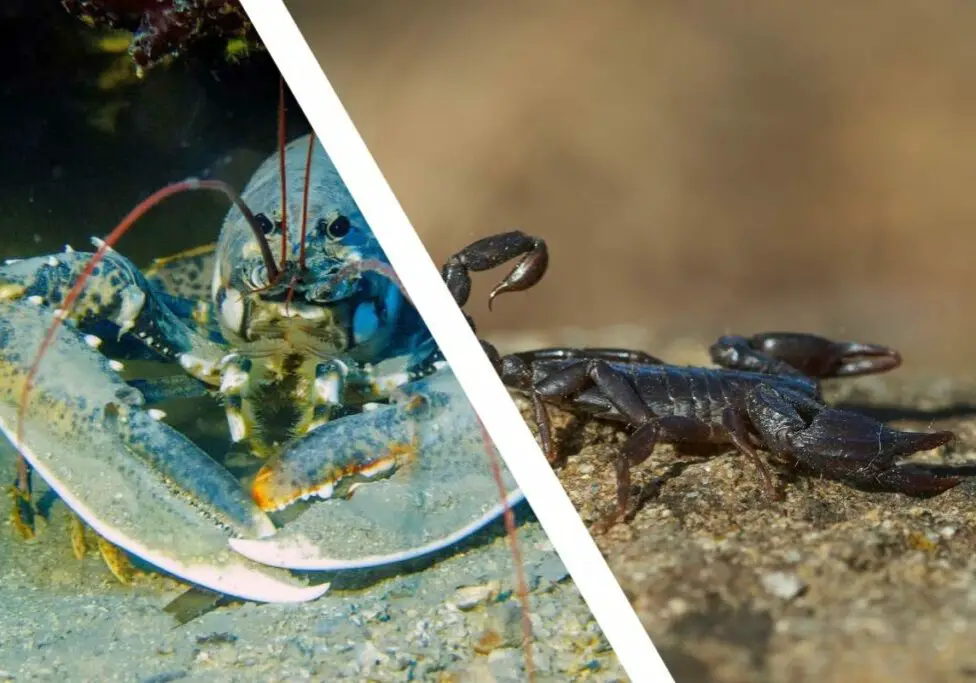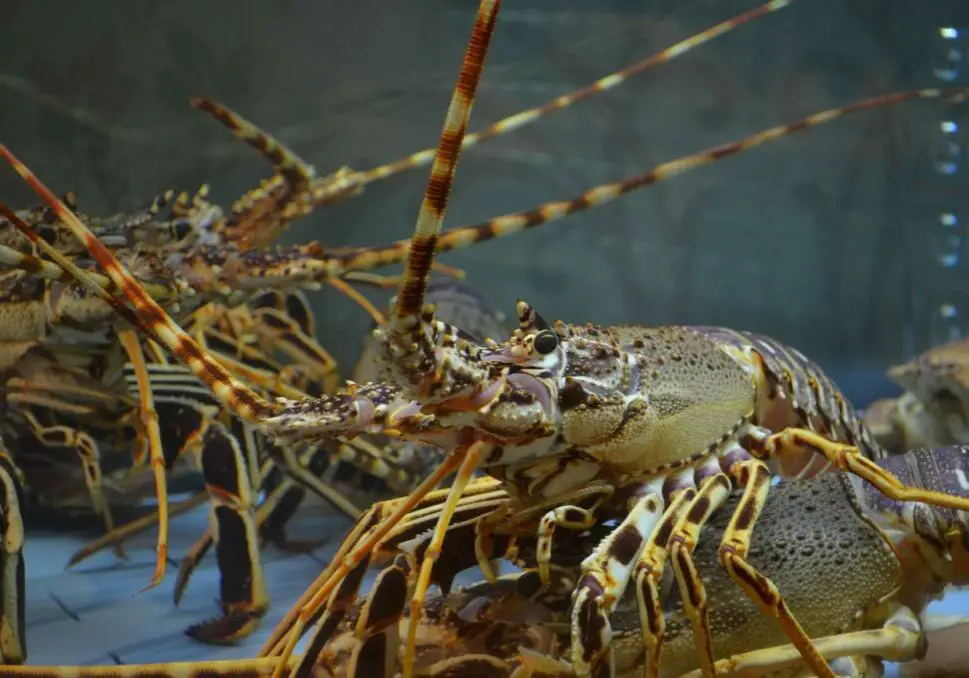Do Starfish Feel Pain? (Explained)
Pain is difficult to test, and it’s not even easy to define. We know it very well as humans, but can we tell what animals feel? Especially starfish and other invertebrates (animals without a backbone) whose bodies are very different from ours. Scientists have been looking for answers for years, but it’s still a lot of guesswork.
Since we can’t get inside animals’ bodies and fully understand their feelings, we can draw conclusions based on their behavior and anatomy. In this article, I’ll answer whether starfish feel pain or not based on scientists’ research, but let’s begin with a quick answer:
Starfish, like other invertebrates, can possibly feel pain, but we haven’t exactly proven that yet. They have numerous sensory cells located in the spines, pedicellariae, and tube feet, and based on research on invertebrates, their bodies are capable of feeling pain.
However, this certainly doesn’t tell the whole story. Below I’ll explain how we can identify pain in animals based on scientific research. Furthermore, I’ll describe sea stars’ nervous system and senses, behavioral responses of invertebrates, and explain long-term motivational changes and learning. Next, I’ll draw a conclusion based on other research. Read on!
Identifying pain in animals
As I mentioned, pain is a difficult thing to test. Some animals can’t even make any sound, and obviously, we can’t ask them if they’re in pain. We can’t measure pain directly, but there are ways to identify it in animals, particularly in invertebrates, including sea stars.
Based on scientific research, we can define a few categories to evaluate the potential for pain in starfish and all invertebrates: their anatomy, behavioral responses, and long-term behavior changes.
The first category is their anatomy. Based on science, animals should have a suitable nervous system and sensory receptors to feel anything which means detecting sensory information and communicating it with the body.
The second is behavioral responses, such as limping, rubbing, or nursing wounds. Just like humans, when animals feel pain, they automatically rub part of their body that is irritated.
The third is long-term behavior changes. Animals can show a difference in their behavior after experiencing a painful event, exactly as humans do. For example, after touching fire, we know we should not do that anymore because it causes us pain.
Knowing these categories, let’s now look at sea stars’ bodies and what we know about their responses to a noxious stimulus.
Starfish nervous system and senses
Sea stars are marine decomposers and belong to echinoderms together with sea urchins, sand dollars, brittle stars, sea cucumber, and crinoids. Interestingly, this group of animals is closer to humans and other vertebrates than any other invertebrates on the phylogenetic trees. So, what does the starfish nervous system look like?
Central nervous system
Starfish have radial symmetry, and their nervous system includes an integrated network of nerves inside each arm. They lack an actual brain that we know, but they do have a nerve ring that is an essential part of sea stars’ bodies.
The nerve ring surrounds the mouth that is located at the center of their bodies. This ring connects radial nerves that run the length of starfish’ arms. This creates a sea stars’ nervous system, similar to other Echinoderms’ nervous systems, such as sand dollars, sea urchins, or brittle stars.
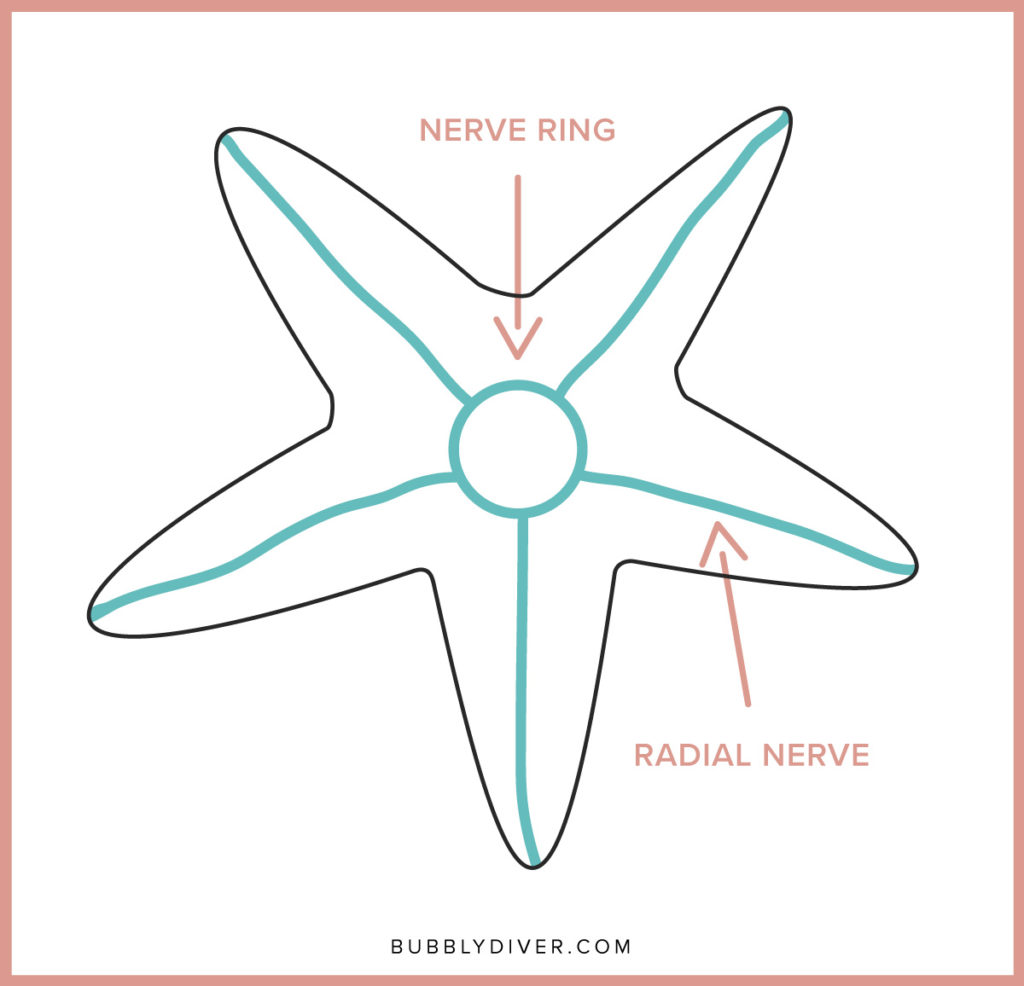
The nerves later control all the starfish movement, react to the stimuli, and store all the information, memories, and decisions about what to do. In addition to that, they coordinate those decisions together.
Interestingly, all the sensory information can be shared between starfish body and their tube feet – small flexible appendages on the underside of their bodies. Starfish’ thousands of tube feet can react autonomously to the stimuli, but when starfish are walking, they can synchronize them and create a bouncing motion – all without a technical brain!
Here you can read more about how starfish move and walk.
Senses
Starfish have sensory cells located in pedicellariae, spines, and tube feet. The most complex sensory organ in starfish bodies is the tip of their tube feet which is actually their eye. Thanks to these sensory cells, starfish are sensitive to light, touch, chemicals, and temperature. Interestingly, starfish can detect odor which helps them to identify food.
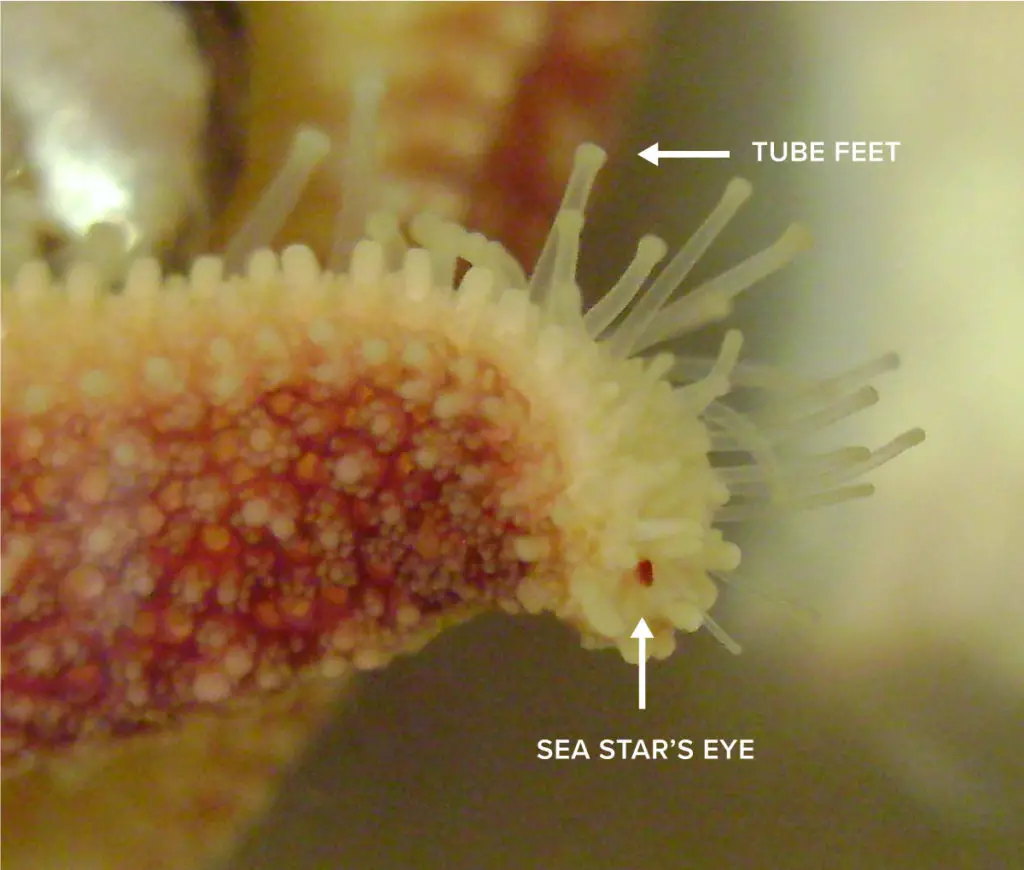
Sea stars’ eyes enable them to see the light, dark, and large structures. Their eyes primarily help them to find a way home – coral reefs. Their eyes have about 120 photoreceptors and a similar number of pigment cells displayed in seven to eight layers along the long axis.
Behavioral responses to pain
Even though there has been no research on starfish specifically, it’s worth mentioning other research on invertebrates whose bodies are very similar to starfish. Professor Robert Elwood has been looking for ways to answer the question of invertebrates feeling pain, and he conducted a lot of research, mostly on crustaceans. His results are fascinating, and we can definitely draw some conclusions from them.
Reflex vs. pain
It’s important to mention that reflex is often not considered a sign of pain. Reflex is an unconditioned response that we experience – for example, when we touch a hot iron, we immediately pull it away. Pain is the conscious experience that happens after the signals have reached the brain.
Therefore, when an animal responds to something, we’d think it’s painful, it doesn’t necessarily mean the animal is in pain, but it’s a simple reflex. That’s why scientists often look for responses beyond reflex, for example, animals rubbing or nursing a wound.
Pain responses
Professor R. Elwood conducted one of his research on prawns. He brushed their antennae with acetic acid, and they began grooming their treated antennae with complex movements of both front legs. Furthermore, their rubbing activity decreased when a local anesthetic was applied before the experiment.
Another examinated animal was a crab. R. Elwood applied a brief electric shock to a part of the hermit crab body. He noticed the crab rubbing that sport with its claws for a long time.
Furthermore, he placed crabs in a bright tank with two shelters. Crabs prefer hiding during the day under rocks, so in this case, they would probably pick one of the shelters to hide. He gave them a brief shock inside one of the shelters, which forced crabs to go outside.
After only two attempts, the crabs were more likely to switch shelters. He says, “So there is rapid learning, just what you would expect to see from an animal that experienced pain.”
In our case, however, sea stars don’t have apparent organs to rub their wounds as crabs do. However, what’s interesting is that Robyn Crook, an evolutionary neurobiologist, examined squids and noticed that they might experience pain entirely differently.
Right after a squid’s fin was crushed, nociceptors became active, but not only where the wound was. They became active across a large part of the squid’s body, extending to the opposite fin. It could suggest that if this animal feels pain, it may hurt all over, rather than feeling it in one spot.
We’re not sure yet why this would happen, but it makes sense from the animal’s perceptive. The squid’s tentacles can’t reach many parts of its body, so it couldn’t even tend its wound.
What’s more, squids are forced to move all the time because of their fast metabolism and keep hunting. An injured squid with all-over heightened sensitivity may stay more alert and sensitive to touch and visual stimuli. “Its long-term behavior changes,” she says. “This fulfills one important criterion for pain.”
Long-term motivational change and learning
The experiment on hermit crabs also showed the long-term changes in their behavior after noxious stimuli. Crabs received a shock in their shell, whereas other control crabs weren’t shocked. Next, the crabs were offered a new empty shell, and a change in motivation was observed. Shocked crabs more quickly approached and moved to the new shell.
This behavior change towards shells clearly shows that crabs are motivated to switch shelters after shock and suggests that they learned that the current shell is low-quality. This shift in motivation was noted 24 hours after the noxious stimulus and proves that the change in the behavior is not just a reflex. Such learning has been demonstrated not only on crabs but on other crustaceans and fish as well.
Conclusion
People for a long time rejected the idea of pain in invertebrates like crustaceans because they thought these animals respond to noxious stimuli only by reflex. The examples above clearly show that this is not the case, but it also doesn’t mean that pain is proven.
We simply don’t know, and probably never will know, what exactly invertebrates and starfish feel when exposed to noxious stimuli. What’s more, pain, in this case, can neither be proven nor disproven. However, we must accept the possibility of pain.
Even though there was no research on starfish yet, we can definitely draw a conclusion based on previous research and sea star anatomy. We know that sea stars have a nervous system, so they’re capable of feeling.
We’ll probably never know how exactly starfish experience pain, but we should always keep in mind that sea stars, just like other animals, are living beings and deserve ethical consideration. Keep that in mind when you see sea stars by the shore or in the water when diving and never touch anything underwater. You can not only cause animals to feel pain but also transfer diseases.
Sources
- Ruppert, Edward E.; Fox, Richard, S.; Barnes, Robert D. (2004). Invertebrate Zoology, 7th edition.
- Elwood Robert W. (2019) Discrimination between nociceptive reflexes and more complex responses consistent with pain in crustaceansPhil. Trans. R. Soc. B3742019036820190368 http://doi.org/10.1098/rstb.2019.0368
- Elwood R. W. (2021). Potential Pain in Fish and Decapods: Similar Experimental Approaches and Similar Results. Frontiers in veterinary science, 8, 631151. https://doi.org/10.3389/fvets.2021.631151
You may also like:
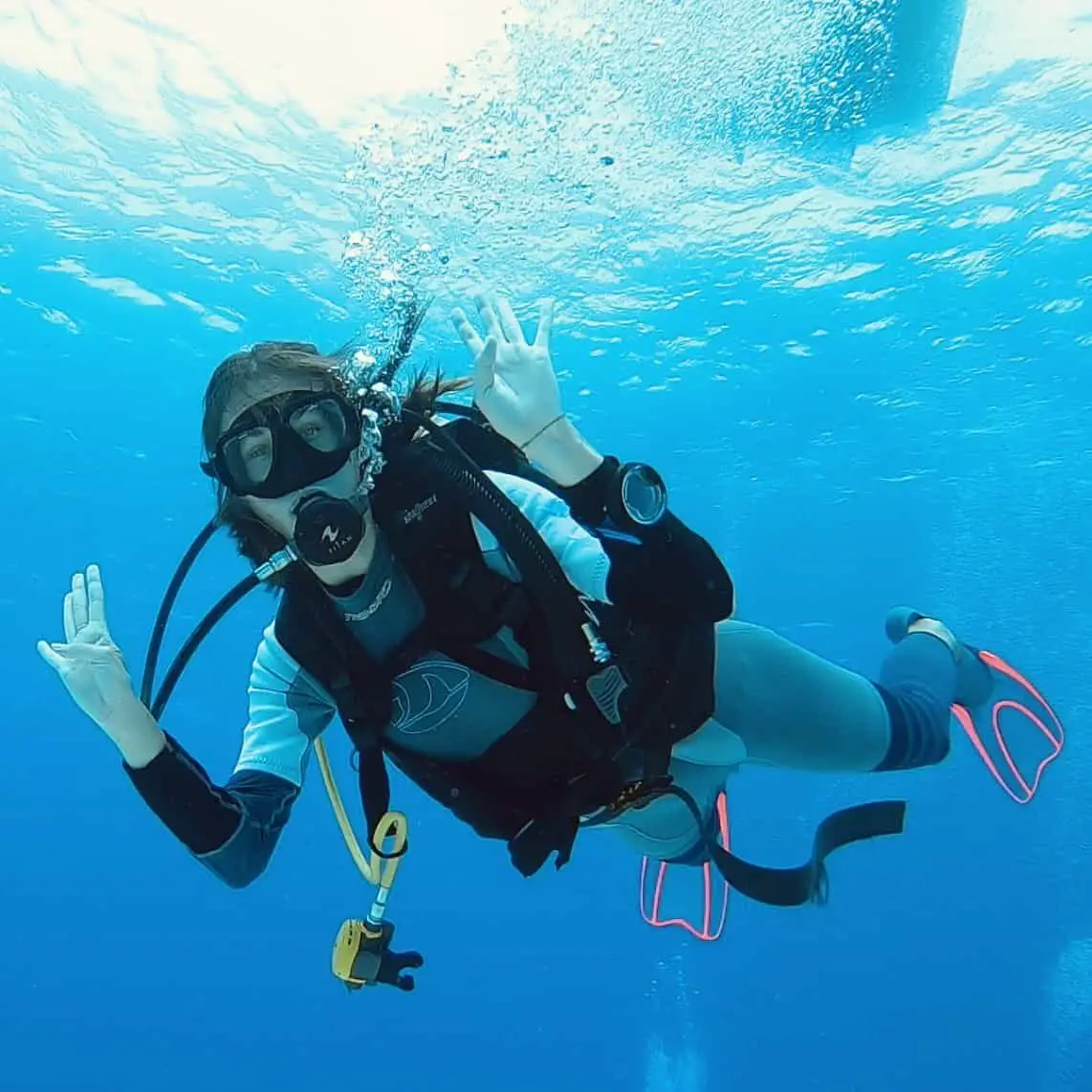
Welcome to Bubbly Diver!
I’m glad to see you here. This blog is created for all marine creature lovers by a bubbly diver - me, Dori :)

